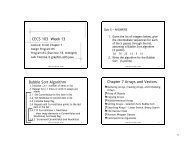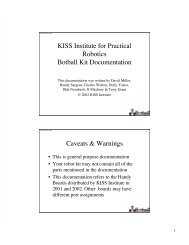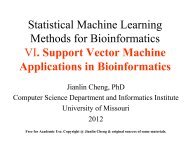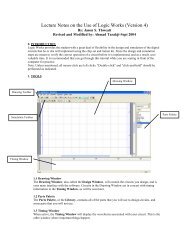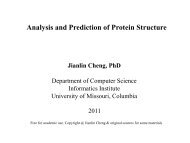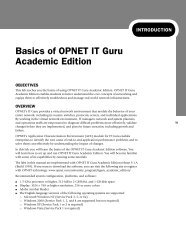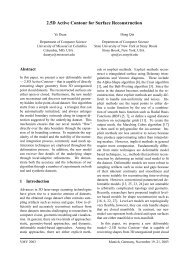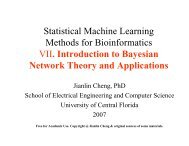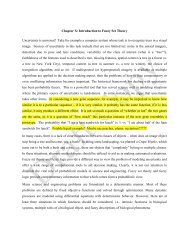Machine Learning Methods for Protein Structure ... - ResearchGate
Machine Learning Methods for Protein Structure ... - ResearchGate
Machine Learning Methods for Protein Structure ... - ResearchGate
You also want an ePaper? Increase the reach of your titles
YUMPU automatically turns print PDFs into web optimized ePapers that Google loves.
44 IEEE REVIEWS IN BIOMEDICAL ENGINEERING, VOL. 1, 2008<br />
Fig. 5. Four-dimensional protein structure prediction. Four-dimensional prediction<br />
derived by docking individual protein chains to create a protein complex.<br />
of more powerful pattern recognition and nonlinear function<br />
fitting methods, new approaches have been used to predict<br />
protein secondary structures. In the 1980s, feed<strong>for</strong>ward neural<br />
networks were first applied to secondary structure prediction<br />
and significantly improved prediction accuracy to a level in<br />
the 60% to 70% range [48]. This was probably the first time a<br />
large-scale machine learning method was successfully applied<br />
to a difficult problem in bioin<strong>for</strong>matics. A third important<br />
breakthrough occurred with the realization that higher accuracy<br />
could be achieved by using a richer input derived from a multiple<br />
alignment of a sequence to its homologs. This is due to<br />
the fact that protein secondary structure is more conserved than<br />
protein primary sequence—i.e., protein sequences in the same<br />
protein family evolving from the same ancestor have different<br />
amino acid sequences but often maintain the same secondary<br />
structure [50], [51]. Rost and Sander [22], [23] were the first to<br />
combine neural networks with multiple sequence alignments<br />
to improve secondary structure prediction accuracy to about<br />
70%–74%. In this approach, instead of encoding each amino<br />
acid with a sparse binary vector of length 20 containing a single<br />
1-bit located at a different position <strong>for</strong> each different amino<br />
acid, the empirical probabilities (i.e., normalized frequencies)<br />
of the 20 amino acids appearing in the corresponding column<br />
of the multiple sequence alignment are used. The positional<br />
frequency vector, called the profile of the family at the corresponding<br />
position, captures evolutionary in<strong>for</strong>mation related<br />
to the structural properties of the protein family. Profiles are<br />
relatively easy to create and allow one to leverage in<strong>for</strong>mation<br />
contained in the sequence databases (e.g., SWISSPROT [53])<br />
that are much larger than the PDB. Profiles are now used<br />
in virtually all knowledge-based protein structure prediction<br />
methods and have been further refined. For instance, PSI-PRED<br />
[24] uses PSI-BLAST [54] to derive new profiles based on<br />
position specific scoring matrices to further improve secondary<br />
structure prediction.<br />
New algorithmic developments [49], [27] inspired by the<br />
theory of probabilistic graphical models [21] have led to more<br />
sophisticated recursive neural network architectures to try to<br />
improve prediction accuracy by incorporating in<strong>for</strong>mation<br />
that extends beyond the fixed-size window input of traditional<br />
feed<strong>for</strong>ward neural networks. Large ensembles of hundreds of<br />
neural networks have also been used [55]. The new technologies<br />
available along with the increase of protein sequence databases<br />
used to build profiles have improved secondary structure prediction<br />
accuracy to about 78%–80%. Moreover, hybrid methods<br />
[45], [57] that combine neural network approaches with homology<br />
searches have been developed to improve secondary<br />
structure prediction. Homologous proteins are proteins that are<br />
derived from the same evolutionary ancestor and there<strong>for</strong>e tend<br />
to share structural and functional characteristics. A protein that<br />
is strongly homologous to another protein with known structures<br />
in the PDB [15] will likely share a similar structure. In<br />
addition to neural networks, support vector machines (SVMs)<br />
are also another set of statistical machine learning methods<br />
used to predict protein secondary structures and other 1-D<br />
features of globular proteins with good accuracy [58].<br />
<strong>Machine</strong> learning methods are also frequently used to predict<br />
1-D feature of membrane proteins. For instance, neural networks<br />
as well as HMMs have been used to identify membrane<br />
proteins and predict their topology, which include predicting the<br />
location of their alpha-helical or beta-strand regions and the intracellular<br />
or extracellular localization of the loop regions [59],<br />
[96].<br />
While 1-D prediction methods have made good progress<br />
over the past three decades, there is still room <strong>for</strong> some improvement<br />
in both the accuracy and scope of these methods.<br />
For instance, secondary structure prediction accuracy is still at<br />
least 8% below the predicted limit of 88% [60]. The prediction<br />
of protein domain boundaries [33], [40]–[42] and disordered<br />
regions [43]–[45] are still at an early stage of development,<br />
while already showing promising results. Some improvements<br />
may come from algorithmic improvements, <strong>for</strong> instance using<br />
ensemble and meta-learning techniques such as bagging and<br />
boosting [62] to combine classifiers to improve accuracy. Other<br />
improvements may require exploiting new sources of biological<br />
in<strong>for</strong>mation. For instance, gene structure in<strong>for</strong>mation, such<br />
as alternative splicing sites, may be used to improve domain<br />
boundary prediction [42].<br />
III. MACHINE LEARNING METHODS FOR 2-D<br />
STRUCTURE PREDICTION<br />
The classic 2-D structure prediction problem is the prediction<br />
of protein contact maps [28], [63], [64]. A protein contact map<br />
is a matrix , where is either one or zero, depending on<br />
whether the Euclidean distance between the two amino acids at<br />
linear positions and is above a specified distance threshold<br />
(e.g., 8 Angstroms) or not. Distances can be measured, <strong>for</strong><br />
instance, between corresponding backbone carbon atoms.<br />
A coarser contact map can be derived in a similar way by<br />
considering secondary structure elements. Finer contact maps<br />
Authorized licensed use limited to: University of Missouri System. Downloaded on April 8, 2009 at 18:32 from IEEE Xplore. Restrictions apply.



